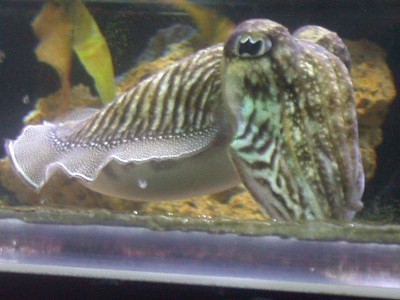 * Sounds Fishy, but Zebra-like Stripes can Move: Bob Enyart and co-host Fred Williams have a fun time on this episode of Real Science Friday talking through the January to March 2010 issue of Creation magazine including on:
* Sounds Fishy, but Zebra-like Stripes can Move: Bob Enyart and co-host Fred Williams have a fun time on this episode of Real Science Friday talking through the January to March 2010 issue of Creation magazine including on:
- Cuttlefish change color and design by extraordinary and intricate mechanisms
- Lessons from genes that give personality to dog hair
- Quick review of caterpillar-to-butterfly nail in Darwin's coffin
- The 150-million year old squid fossil with ink still able to be reconstituted
- Retrograde orbits and rotations challenge the condensing Nebula theory of solar system formation
- Tracks that show dinosaurs dragging its tail, sitting down, and then lifted by water scratched the sand with it's claws
- Chimps less able to learn than evolutionists had expected
- Since Darwin's Tree of Life has been debunked, genes are revealing amazing things
- Programmed cell death undermines survival of the fittest
- Post-show note: the extraordinary ability of the color blind octopus (as shown in the YouTube video below) to turn color almost immediately to camouflage itself.
CORRECTION: Bob Enyart had wrongly stated that the "still inky" squid ink was liquid, which it was not, but it had not decomposed, it had merely dried out (dessicated). Now, thanks to TOL evolutionist Alate_One pointing out the error, the following has been corrected:] The British Geological Survey's Dr. Phil Wilby, who excavated the fossil, said, "It is difficult to imagine how you can have something as soft and sloppy as an ink sac fossilised in three dimensions, still black, and inside a rock that is 150 million years old." And the Daily Mail states that, "the black ink was of exactly the same structure as that of today’s version." And the Telegraph reports that scientists "cracked open what appeared to be an ordinary looking rock only to find the one-inch-long black ink sac inside. After realising what they had stumbled across, they took out a small sample of the black substance and ground it up with an ammonia solution. Remarkably, the ink they created was good enough to allow them to draw..." and Dr. Wilby added, "Normally you would find only the hard parts like the shell and bones fossilised but... these creatures... can be dissected as if they are living animals, you can see the muscle fibres and cells. It is difficult to imagine how you can have something as soft and sloppy as an ink sac fossilised in three dimension, still black, and inside a rock that is 150 million years old. The structure is similar to ink from a modern squid so we can write with it..." And the reason this is difficult to imagine is because, as Dr. Carl Wieland writes, "Chemical structures 'fall apart' all by themselves over time [let alone 150 million years of it] due to the randomizing effects of molecular motion."
Today's Resource: Have you browsed through our Science Department in the KGOV Store? Check out especially Walt Brown's In the Beginning and Bob's interviews with this great scientist in Walt Brown Week! You'll also love Dr. Guillermo Gonzalez' Privileged Planet (clip), and Illustra Media's Unlocking the Mystery of Life (clip)! You can consider our BEL Science Pack; Bob Enyart's Age of the Earth Debate; Bob's debate about Junk DNA with famous evolutionist Dr. Eugenie Scott; and the superb kids' radio programming, Jonathan Park: The Adventure Begins! And Bob strongly recommends that you subscribe to CMI's tremendous Creation magazine!
